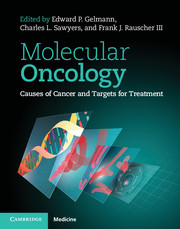Book contents
- Frontmatter
- Dedication
- Contents
- List of Contributors
- Preface
- Part 1.1 Analytical techniques: analysis of DNA
- Part 1.2 Analytical techniques: analysis of RNA
- Part 2.1 Molecular pathways underlying carcinogenesis: signal transduction
- Part 2.2 Molecular pathways underlying carcinogenesis: apoptosis
- Part 2.3 Molecular pathways underlying carcinogenesis: nuclear receptors
- Part 2.4 Molecular pathways underlying carcinogenesis: DNA repair
- Part 2.5 Molecular pathways underlying carcinogenesis: cell cycle
- Part 2.6 Molecular pathways underlying carcinogenesis: other pathways
- Part 3.1 Molecular pathology: carcinomas
- Part 3.2 Molecular pathology: cancers of the nervous system
- Part 3.3 Molecular pathology: cancers of the skin
- 61 Squamous-cell carcinoma
- 62 Molecular oncology of basal cell carcinomas
- 63 Melanoma
- Part 3.4 Molecular pathology: endocrine cancers
- Part 3.5 Molecular pathology: adult sarcomas
- Part 3.6 Molecular pathology: lymphoma and leukemia
- Part 3.7 Molecular pathology: pediatric solid tumors
- Part 4 Pharmacologic targeting of oncogenic pathways
- Index
- References
61 - Squamous-cell carcinoma
from Part 3.3 - Molecular pathology: cancers of the skin
Published online by Cambridge University Press: 05 February 2015
- Frontmatter
- Dedication
- Contents
- List of Contributors
- Preface
- Part 1.1 Analytical techniques: analysis of DNA
- Part 1.2 Analytical techniques: analysis of RNA
- Part 2.1 Molecular pathways underlying carcinogenesis: signal transduction
- Part 2.2 Molecular pathways underlying carcinogenesis: apoptosis
- Part 2.3 Molecular pathways underlying carcinogenesis: nuclear receptors
- Part 2.4 Molecular pathways underlying carcinogenesis: DNA repair
- Part 2.5 Molecular pathways underlying carcinogenesis: cell cycle
- Part 2.6 Molecular pathways underlying carcinogenesis: other pathways
- Part 3.1 Molecular pathology: carcinomas
- Part 3.2 Molecular pathology: cancers of the nervous system
- Part 3.3 Molecular pathology: cancers of the skin
- 61 Squamous-cell carcinoma
- 62 Molecular oncology of basal cell carcinomas
- 63 Melanoma
- Part 3.4 Molecular pathology: endocrine cancers
- Part 3.5 Molecular pathology: adult sarcomas
- Part 3.6 Molecular pathology: lymphoma and leukemia
- Part 3.7 Molecular pathology: pediatric solid tumors
- Part 4 Pharmacologic targeting of oncogenic pathways
- Index
- References
Summary
Introduction
Squamous-cell carcinomas (SCCs) form the predominant histological type of cancers arising from the head and neck (HNSCC; oral and nasal cavities, paranasal sinuses, pharynx, and larynx), uterine cervix, and skin; and a subset of carcinomas arising from the lung and esophagus (1). Those arising in the head and neck, lung, and esophagus are predominantly associated with tobacco and alcohol use, which contain polyaromatic hydrocarbons, sulphites, and acetaldehydes that can induce mutagenesis of key tumor-suppressor genes, such as CDKN2A and TP53, or mutagenesis or over-expression of oncogenes, such as EGFR, c-MET, or RAS. Most cervical SCC, and a subset of SCC arising in the oropharynx and skin of the anogential region, are associated with human papilloma viruses (HPVs). These viruses encode E6 and E7 oncogenes that inactivate important tumor-suppressor proteins TP53 and RB, and activate nuclear factor-kappaB (NF-κB). A subset of nasopharygeal carcinomas is associated with Epstein–Barr viruses (EBVs), which express LMP-1, an oncogene that also activates NF-κB. Most skin SCC arise in sun-exposed areas due to ultraviolet-light-induced carcinogenesis. Because much of what has been learned about the molecular pathogenesis of tobacco and HPV-related HNSCC applies to lung, esophageal, or cervical SCC, emphasis will be given to alterations common to HNSCC and SCC arising from these sites.
Tumor-suppressor genes in SCC
A genetic progression model for HNSCC has been defined by micro-satellite analysis for allelic loss at multiple loci (2). Important tumor-suppressor genes altered by genetic and epigenetic events and their consequences are illustrated in Figure 61.1, left side. A locus at 9p21 frequently undergoes loss of heterozygosity (LOH) during development of squamous hyperplasia and SCC (2). This locus encodes proteins p16INK4a and p14ARF, and is inactivated in the majority of HNSCC by homozygous deletion, mutation, or by methylation of the regulatory promoter region (3). The p16INK4a protein is a cyclin-dependent kinase (CDKN2A/MTS-1/INK4A) that inhibits cell-cycle progression. Re-expression of p16INK4a in HNSCC cells by gene transfer suppresses cell growth in vitro (4). p14ARF is an important activator of the TP53 tumor-suppressor pathway and repressor of the NF-κB pro-survival pathway (5,6). Re-expression of p14ARF has been shown to reactivate TP53, and repress NF-κB-mediated pro-survival gene expression and promote cell death in other cell lines (6). Thus, genetic or epigenetic alteration of this locus can result in loss of p16INK4a, causing increased proliferation, and p14ARF protein, causing decreased programmed cell death.
- Type
- Chapter
- Information
- Molecular OncologyCauses of Cancer and Targets for Treatment, pp. 686 - 692Publisher: Cambridge University PressPrint publication year: 2013

